Adam Nankervis
Black stars on a white sky
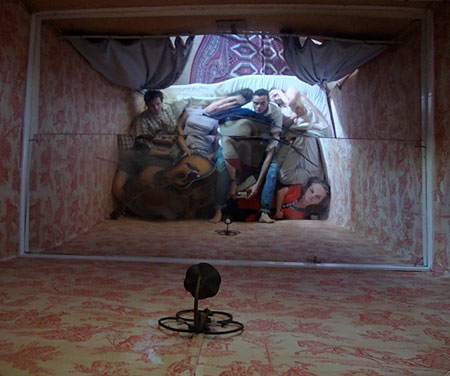
Cannon
(Hermine Demoriane - Hilary Kitz - Deborah Wargon (words and music)
Stefan Armour (piano) - Presented by Adam Nankervis)
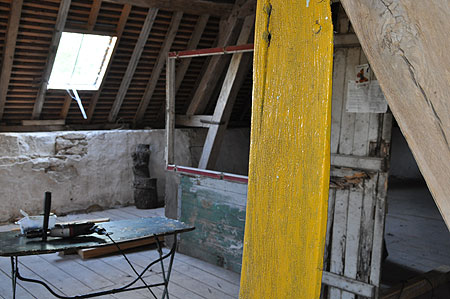
Black stars on a white sky
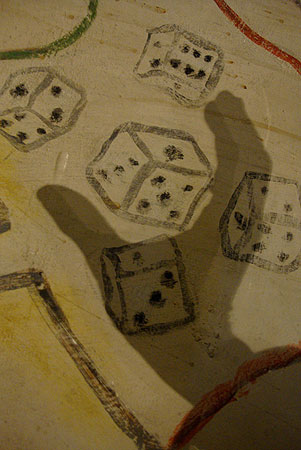
Shadow play on a detail of Jean Cocteau’s
fresca at Notre Dame de France, London
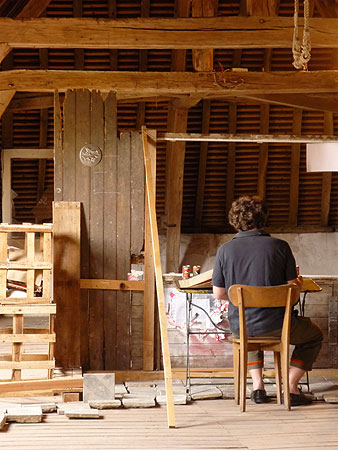
Black stars on a white sky - Details of installation
Adam Nankervis and Museum MAN
Mr Clean, the Jolly Green Giant, Michelin Man, Chiquita Banana, Mr Peanut…. Manufacturers have always had the tendency to personify their products in a comic way with a human or animal ikon, with little statuettes or with drawn images, especially in the USA. Adam Nankervis has a particular fondness for these kind of characters (and others that have no name, and no brand). He picks them up in jumble sales, car boot sales and charity shops. But they are only one component of the live-in, itinerant, constantly mutating artistic project he calls Museum MAN.
It all started with the discovery of an abandoned flat in the former East Berlin, vacant but still crammed with the paraphernalia of its deceased owner. Nankervis was overwhelmed by the mundane but intense evidence of another life, a personal thread which touched at certain points the received history of a former period. “Snapshots of family and friends, mementos and letters, personal items frayed and torn, albums of historic and aesthetic importance mixed with DDR castes of rewards, medals, knives, radios, WW II helmets, a uniform, personal effects, a STASI typewriter ….” The flat was a sort of involuntary museum constituted at the moment it was left by its human inhabitant. After paying his respects, Nankervis wondered if such a varied and minutely detailed memorial of the deceased could be turned around to become a lived-in museum conceived as “a model incorporating the new”.
Museums are about stillness, places of dust (at least they were until they became the major component of the leisure industries they are today). But Museum MAN is a phenomenon of movement, in several ways:
- Materials are constantly being collected and continually rearranged in relation to space, and to each other, to bring out fresh readings.
- The museum itself moves as Nankervis moves about the world, being completely or partially reconstituted in a new geographical and cultural context.
- The museum welcomes the work of other artists, to be seen in contrast to, or in dialogue with, what is already there.
As the artist puts it: “The bringing together of objects to be read as autonomous entities and threaded for a re-telling by their interrelationship in harmonics when situated together”. There is a sense of profusion, of teeming objects and images, and therefore multitudes of relationships. Museum MAN is in “maximalist overdrive”, in Nankervis’s words, “disparate, haemorrhaging, coalescing, unifying”.
But of course these are all generalities. It is the specific sensibility that makes the choices and creates the relationships between objects that we respond to, without necessarily being able to say why we are drawn to it. Just recently there has been a kind of revival of interest among museums in their early beginnings as the Cabinets of Curiosities of the 17th century, the collections of incongruous objects put together by scholars and wealthy amateurs in their homes. I saw an exhibition informed by this idea recently at the Gemeentemuseum in De Haag, called Wonder-kamas, and it was a total disaster. All manner of objects brought out of the storerooms and put together - but no poetry, no energy, no harmony, no edge, nothing generated in the relations between them.
This is exactly where Adam Nankervis excels. There is poetry in his salvaged ensembles.
Not that the quality of ‘poetry’ should exclude the painterly. One of his recent incarnations of Museum MAN has been SHOULD THE WORLD BREAK IN, which was shown at the Bereznitsky Gallery in Kiev in the Ukraine. The word ‘break’ is a key generator in the title. Whether it was old planks, drawings, photographs, paintings, bits of frame, or furniture, the work had a beautiful tonal consistency across its entirely, The half-broken or roughly assembled bricolage of materials only added to the work’s humane response, a response which was amplified when I learned that the structure was made from wood from demolished refugee houses after the fall-out from Chernobyl. In Nankervis’s work it was as if that total dislocation of people’s lives and break down of their health was materially testified to, but also soothed by a kind of painterly balm.
Ernst Fraenkel, the 19th century philologist writing about the typography of poem “Un coup de dés” by Stéphane Mallarmé, observed that a throw of the dice did not abolish chance: the dots on the faces of the dice and the dots over the letter “i” were “black stars on a white sky”. Museum Man invited artists, writers and poets to contribute to a book which would offer a variety of readings (or misreadings) for an age of blurred definitions and uncertainty, an age of rediscovery. The book is housed in an attic above a barn, whose exposed roof beams might be the open pages of a book. In the middle of the floor an open frame has been installed, made of doors and planks found in the grounds of thechâteau . A single table and chair present the austere artifice of a deck or cockpit echoing the book’s nakedness. From its exterior components (table, chair, book) the spectator is invited to enter the work and become part of it. This creates two states in an allegory: the reading from the table (within/without) and the observation of the reader (without/within) An open and a closed book. A.N.
Previous Work
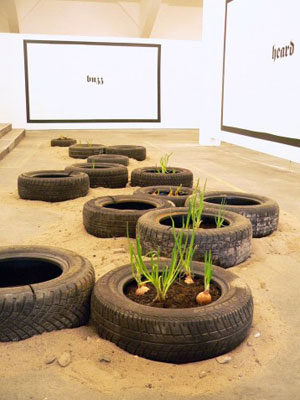
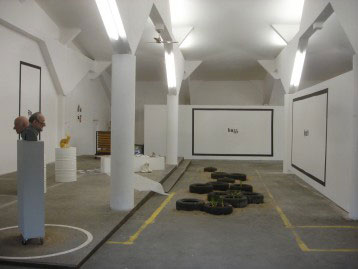
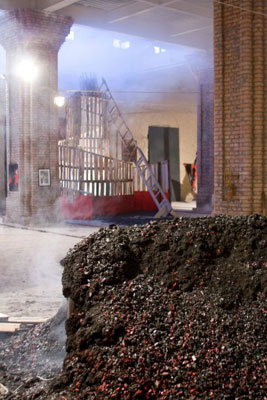
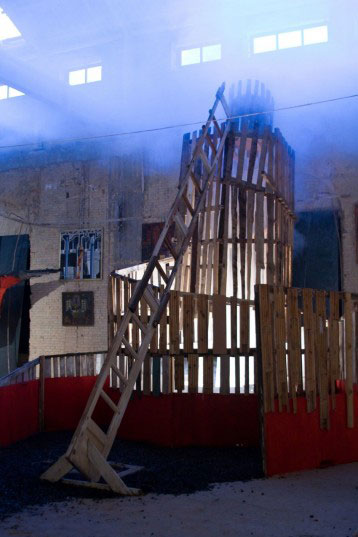
Above: Reliquaries Of Empires Dust-I Heard A Fly Buzz-installation, Berlin 2009
Below: A spires Embers Tower, Kiev 2009